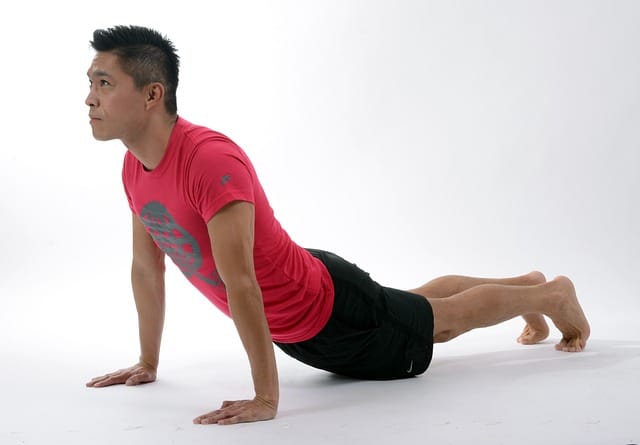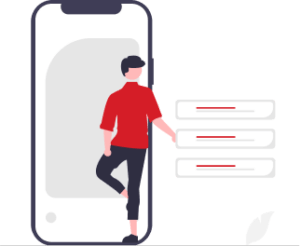Table Tennis Warm-Ups You Should Do Before Every Game
- Eugene Sandoval
- Last updated
You should begin every session with a table tennis session warm-up. I recommend starting with a few exercises to elevate your heart rate, then move on to stretches, and finally finish with some skill training to get your eye in.
Here is a table tennis warm-up example:
- High knees (2-3 minutes)
- Side-to-side movements (2-3 minutes)
- Twisting reverse lunges (5-10 reps per leg)
- Arm circles (small to large)
- Side trunk stretch and trunk twists (2-4 reps per side)
- Backhand-to-backhand exchanges (2-3 minutes)
- Loop against block (2-3 minutes)
Some people don’t bother with a table tennis warm-up, but I advise against this. Not only does it increase your risk of injury, but it also reduces the quality of your performance. Considering a quality ping pong warm-up can take less than 15 minutes, you really should make sure you do it.
Below I go into more depth on the importance of warming up and give you some ideas to create your own warm-up structure.
Do you want more advanced coaching?
- 20+ Hours of Training
- From Beginner to Master
- Coached by Chinese National Champion
Table of Contents
Why It’s Important to Warm-Up for Table Tennis

The importance of warm-ups cannot be understated. Table tennis is a game that requires speed, agility, and fast reaction times — it’s a vigorous activity. The American Heart Association recommends warming up before working out to protect your heart’s health. Warming up before a table tennis game allows you to:
Move Faster
Speed is an essential part of playing ping pong well. Warm muscles contract with more force and release more rapidly. By exercising before each match, you’ll have more power and better reactions, and you’ll be able to reach shots quicker allowing you to dominate the table.
Reduces the Risk of injury
Warming up properly is one of the best ways of avoiding injuries while playing table tennis. A good training session increases your body temperature, which improves muscle elasticity, thus reducing the risk of muscle or tendon injuries. A warm body also delivers more oxygen to the muscles, reducing the risk of cramps.
Learn from my mistakes. I didn’t warm up properly a few years ago and sustained a serious back injury which sidelined me for about a year!
Helps You Mentally Prepare
A physical warm-up session is a great way to prepare your mental game and focus for upcoming matches. Being in the right frame of mind and having good table tennis psychology is just as important as warming up your body for a game.
Improves Your Range of Motion

Warming up properly with flexibility exercises ensures you have a full range of movement. This helps you to store more potential energy which leads to faster shots.
Read More: 15 Table Tennis Tips to Help You Improve
My Recommended Table Tennis Warm-Up Exercises
The perfect table tennis warm-up session consists of three different sections: a cardiovascular portion, a flexibility portion, and finally, a skill portion. By applying all three, you fully prepare yourself to play to the best of your ability without risk of injury.
Cardiovascular Warm-Up Exercises for Table Tennis
Table tennis may be a fast sport demanding quick reactions, but it isn’t particularly tiring compared to most other racket sports. You only need a reasonable level of fitness to enjoy the game. For your cardiovascular warm-up, two or three low intensity exercises are plenty.
Gently Elevate Your Heart Rate – (2-3 Minutes)
You can do this with a few minutes of very light jogging, marching with high knees, or even shadow play exercises. Moving your large muscle groups gets your heart pumping faster and starts your training session off right.
Star Jumps – (2-3 Minutes)
While star jumps are not particularly common in warm-ups, they are an excellent whole body exercise that elevates your core body temperature and improves blood circulation.
Practice Side-to-Side Movements – (2-3 Minutes)
Practicing your table tennis shuffle steps is a great form of exercise that primes your body for a game. A standard lateral shuffle or table tennis shuffle practice drill gets you warm and builds your game skills at the same time. It works your hip abductors, glutes, calves, and various other muscles.
Table Tennis Stretching Exercises
For the second part of your training session, you should have around 5 minutes of stretching to improve your flexibility. This will help reduce the risk of injury. I recommend incorporating both dynamic and static stretching exercises so that you are fully covered with a focus on the former.
Below are four examples of dynamic stretches that target specific muscle groups.
Twisting Reverse Lunges
This exercise opens your hips and abdomen while working your thighs (quads) and glutes. Start in a standing position. Take a long step back with one foot, lowering into the lunge position, then twist your upper body outward. Repeat 5-10 times with your right and left leg.
Lunging Hamstring Stretch
This exercise stretches your back and hamstrings (back of thigh) along with your hips. Start in a standing position. Take a long step forward with one foot, lowering into the lunge position. Reach your arms forward, resting your fingertips on the ground. Then lift your rear leg until it is straight, rising from the hips, keeping your fingertips on the ground. Repeat 5-10 reps with each leg.
Knee Lifts and Butt Kicks
These dynamic stretches improve the range of motion in the large muscles of the legs while keeping your body warm. You can do both while performing a slow jog on the spot. For knee lifts, lift your knees to hip height with every step. For butt kicks, try to kick the heel of your foot into your buttock with every step. Do each exercise for 15-30 seconds for the right leg and left leg.
Arm Circles
Now that you’ve learned some of the exercises tackling big muscles in the lower body, it’s time to move to the upper body.
One of my favorite exercises is arm circles, so I recommend incorporating them into your new warm-up routine. These help me to limber up when I have shoulder muscle stiffness or muscle tension — usually from too much racket sports!
To perform arm circles, outstretch your arms at shoulder level, and move them in small circular motions in a clockwise rotation. Gradually enlarge the circles until you are using a full range of motion. Afterward, do the same in an anti-clockwise motion, beginning with small circles and gradually enlarging them.
Side Trunk Stretch and Trunk Twist
Table tennis involves a lot of rotation and trunk stretches help to prepare your body for this. For the side trunk stretch, stand in an upright position and lean to the side while keeping your legs right. Attempt to reach past the side of your knee with your left arm. Afterward, do the other side with your right arm.
For trunk twists, while seated or standing, put your hand on your hips and rotate at the hips as much as you can. Make sure to do at least two hip rotations per side.
Wrist Roll
Many people don’t think about including wrist stretches in their warm-up routines, but I strongly recommend you do so. Whether you’re serving, hitting a banana flick, or performing a forehand chop, your wrist is pivotal for the motion. So warm it up well!
I like to do wrist rolls. You can clasp your hands together or do them independently. The goal is to rotate your wrists in as wide of a circular motion as you can manage. It helps give you freedom of movement and reduces the risk of injury.
Learn From the Best — Liam Pitchford’s Warm-Up Routine
A solid way to develop a warm-up routine is to copy the top players. Below you will find the five-step table tennis warm-up of #25-ranked Liam Pitchford.
Read More: 7 Great Ways to Practice Table Tennis Alone
Skill Warm-Up Exercises for Table Tennis
Now that your body is warm and you’ve stretched your major muscle groups it’s time to work on your skills on the table. Spend as long as you like, anywhere from 5 to 15 minutes is a good length.
Don’t just use this time to rally as it isn’t good preparation for a real game. Instead, perform structured drills as this will help you get your eye in and hone your consistency. In competition, focus on warming up your strongest skill. You can dedicate time to tackling your weak areas outside of competition.
Here is a concise skill drill structure that you could adopt:
- 3 minutes of rallying cross-court
- 3 minutes of skill practice for player A
- 3 minutes of skill practice for player B
- 3 minutes of service and receive
Ideally, I recommend spending more time warming up on the table if you can. Below are some drills you may want to consider.
Backhand-to-Backhand Exchanges
Backhand-to-backhand counter-driving is the perfect way to begin your skill warm-up in table tennis. It’s not too quick, so you can play consistently, and it emulates match play rather well. This is because most players hit the ball toward the backhand side as this tends to be the weaker flank. Therefore, back-to-backhand strokes are very common in matches. Equally, forehand drive exchanges are important too, so I recommend incorporating both.
Loop Against Block
Looping is a staple of high-quality table tennis. Being the best shot in the game, it is vital yours is on point if you sport a looping style. Therefore you should incorporate a loop drill into your skill warm-up. I recommend looping against block, as this is far more manageable than if your opponent is countering or looping themselves. I use this type of drill in every one of my warm-ups without fail — both forehand loops and backhand loops.
Begin with controlled looping and focus on proper form. Resist blasting balls your partner’s way until you dial in your co-ordination and consistency.
2 Backhand Topspins and 2 Forehand Topspins
I like this exercise because it equally works your backhand and forehand side while testing your footwork. One of the main problems I see with players today is poor footwork. They have good ball-hitting ability, but they just can’t get their body in the right position to play their best shots most of the time. Starting with an exercise like this forces you to get those feet moving which primes you for match play. It also works your hand-eye coordination far more than if you are hitting from the same position.
Bonus: Fun Table Tennis Warm-Up Games
While I wouldn’t recommend such games for serious play, some players may want to start a session with something fun before getting into intense matches or drills. Here are some fun games you might want to try out.
Around the World
Players cue in lines at either end of the table, and after they hit the ball they run to the other side. Upon missing a shot, said player is eliminated, and the game progresses until just two players are left. At this point, the final two players have a standard rally with a serve to decide the winner.
Double Bounces
For this game, rather than hitting the ball straight back to your opponent, you aim your paddle downwards, hitting the ball onto your side of the table and then to your opponent’s. This makes the game much slower than standard table tennis and tests your patience, placement, and spin.
Spin Game
The spin game compels you to vary your shots. Each time you hit the ball you have to alter the type of spin you produce. So no longer can you play topspin for every ball. Instead, you have to constantly alternate between topspin, backspin, and sidespin.
A cool-down is also important at the end of a session. Cooling down allows your heart and respiration rates to decrease gradually, and it also decreases the chances of light-headedness. As for stretching during a cool-down, this aids the release of lactic acid from your muscles which reduces soreness, stiffness, and cramping.
Begin by spending 5 minutes walking gently, allowing your heart rate to decrease gradually. Then stretch your muscles with static stretches where you stretch just to the point of tension. Do not bounce or stretch to the point of discomfort. Around 10-20 seconds per stretch is sufficient.
Conclusion
Doing proper table tennis warm-ups before a game and cooling down afterward not only protects your health but also helps you play your best game from the first serve to the last stroke. A solid warm-up consists of light cardio, such as a few minutes of light jogging, followed by stretches, and finally, skill training on the table.
Table tennis players who don’t warm up are a bit slower and hesitant at the beginning of their game. This is because their bodies aren’t yet attuned to the activity. Taking just 15 minutes to properly prepare can make all the difference, so don’t skip a warm-up session, and don’t forget to cool down after your game. The warm-up exercises listed here are an excellent starting point for those looking to up their game.
Interesting Read: Best Table Tennis Return Boards
Eugene (Gene) Sandoval has been one of those guys who spent too many hours around ping pong tables in high school. However, soon enough, Gene understood that there is more to ping pong than having fun. That is how he started a journey that made Eugene one of the experienced semi-professional ping pong players in the United States. As the founder of the PingPongRuler, Eugene spends most of his time surrounded by ping pong tables and research. He always has this knack for coming up with new ping pong strategies and telling the good and bad equipment apart.
-
Eugene Sandovalhttps://pingpongruler.com/author/admin/
-
Eugene Sandovalhttps://pingpongruler.com/author/admin/
-
Eugene Sandovalhttps://pingpongruler.com/author/admin/
-
Eugene Sandovalhttps://pingpongruler.com/author/admin/
Popular Products
Join our email list for exclusive reviews & the latest Ping Pong News
Sign up to our newsletter and stay up-to-date with the latest news in the ping pong world, and be the first to read our new product reviews. We promise, no spam

















